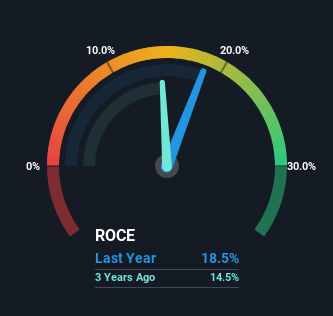Returns On Capital Are Showing Encouraging Signs At Genuine Parts (NYSE:GPC)
Did you know there are some financial metrics that can provide clues of a potential multi-bagger? One common approach is to try and find a company with returns on capital employed (ROCE) that are increasing, in conjunction with a growing amount of capital employed. If you see this, it typically means it's a company with a great business model and plenty of profitable reinvestment opportunities. Speaking of which, we noticed some great changes in Genuine Parts' (NYSE:GPC) returns on capital, so let's have a look.
Return On Capital Employed (ROCE): What Is It?
Just to clarify if you're unsure, ROCE is a metric for evaluating how much pre-tax income (in percentage terms) a company earns on the capital invested in its business. The formula for this calculation on Genuine Parts is:
Return on Capital Employed = Earnings Before Interest and Tax (EBIT) ÷ (Total Assets - Current Liabilities)
0.18 = US$1.8b ÷ (US$18b - US$8.6b) (Based on the trailing twelve months to March 2024).
So, Genuine Parts has an ROCE of 18%. By itself that's a normal return on capital and it's in line with the industry's average returns of 18%.
See our latest analysis for Genuine Parts
In the above chart we have measured Genuine Parts' prior ROCE against its prior performance, but the future is arguably more important. If you're interested, you can view the analysts predictions in our free analyst report for Genuine Parts .
What Can We Tell From Genuine Parts' ROCE Trend?
Investors would be pleased with what's happening at Genuine Parts. The data shows that returns on capital have increased substantially over the last five years to 18%. The amount of capital employed has increased too, by 29%. The increasing returns on a growing amount of capital is common amongst multi-baggers and that's why we're impressed.
On a side note, Genuine Parts' current liabilities are still rather high at 47% of total assets. This can bring about some risks because the company is basically operating with a rather large reliance on its suppliers or other sorts of short-term creditors. While it's not necessarily a bad thing, it can be beneficial if this ratio is lower.
The Bottom Line On Genuine Parts' ROCE
A company that is growing its returns on capital and can consistently reinvest in itself is a highly sought after trait, and that's what Genuine Parts has. Since the stock has returned a solid 83% to shareholders over the last five years, it's fair to say investors are beginning to recognize these changes. In light of that, we think it's worth looking further into this stock because if Genuine Parts can keep these trends up, it could have a bright future ahead.
One more thing to note, we've identified 1 warning sign with Genuine Parts and understanding it should be part of your investment process.
While Genuine Parts may not currently earn the highest returns, we've compiled a list of companies that currently earn more than 25% return on equity. Check out this free list here.
Have feedback on this article? Concerned about the content? Get in touch with us directly. Alternatively, email editorial-team (at) simplywallst.com.
This article by Simply Wall St is general in nature. We provide commentary based on historical data and analyst forecasts only using an unbiased methodology and our articles are not intended to be financial advice. It does not constitute a recommendation to buy or sell any stock, and does not take account of your objectives, or your financial situation. We aim to bring you long-term focused analysis driven by fundamental data. Note that our analysis may not factor in the latest price-sensitive company announcements or qualitative material. Simply Wall St has no position in any stocks mentioned.

 Yahoo Finance
Yahoo Finance 
